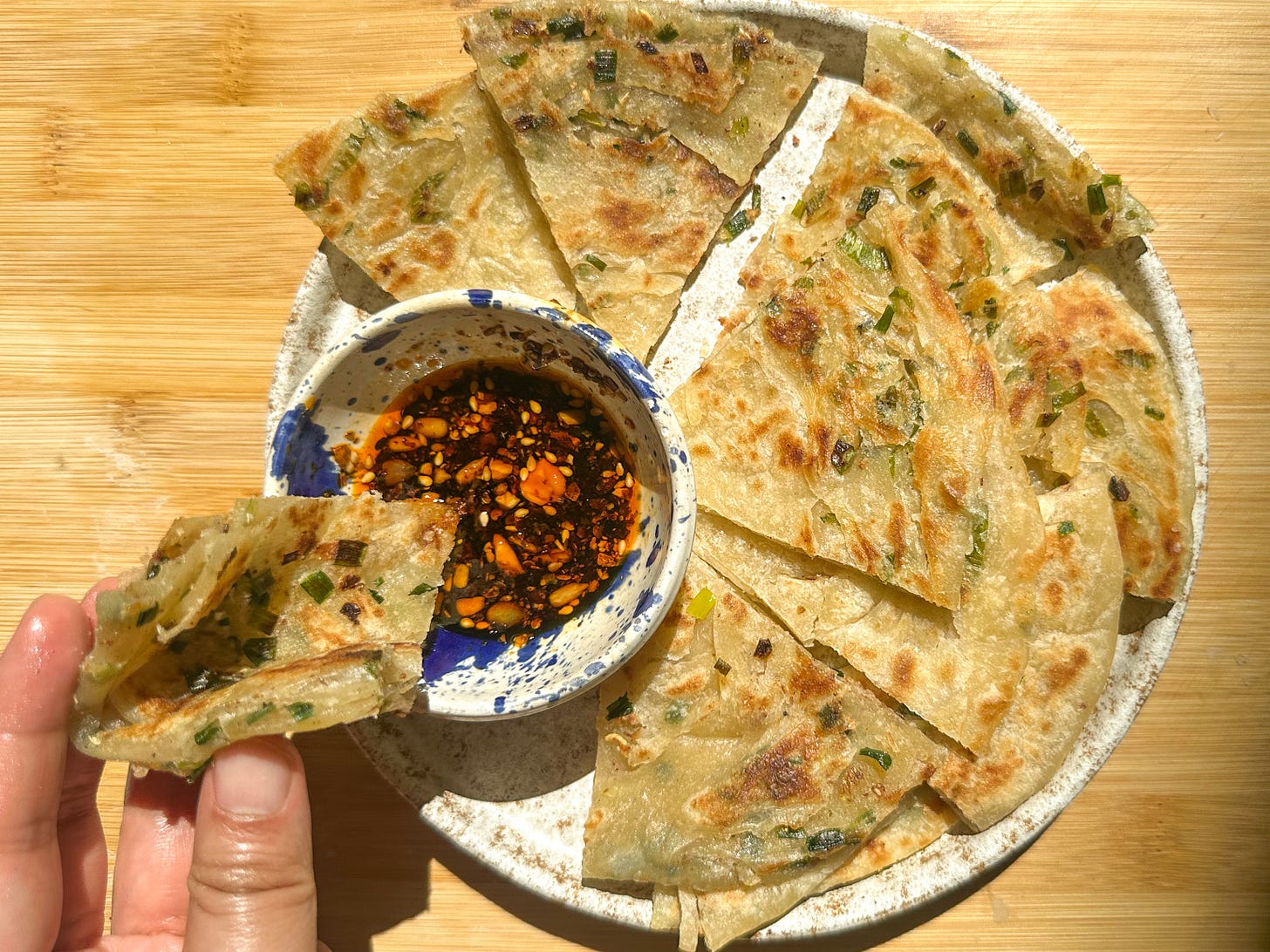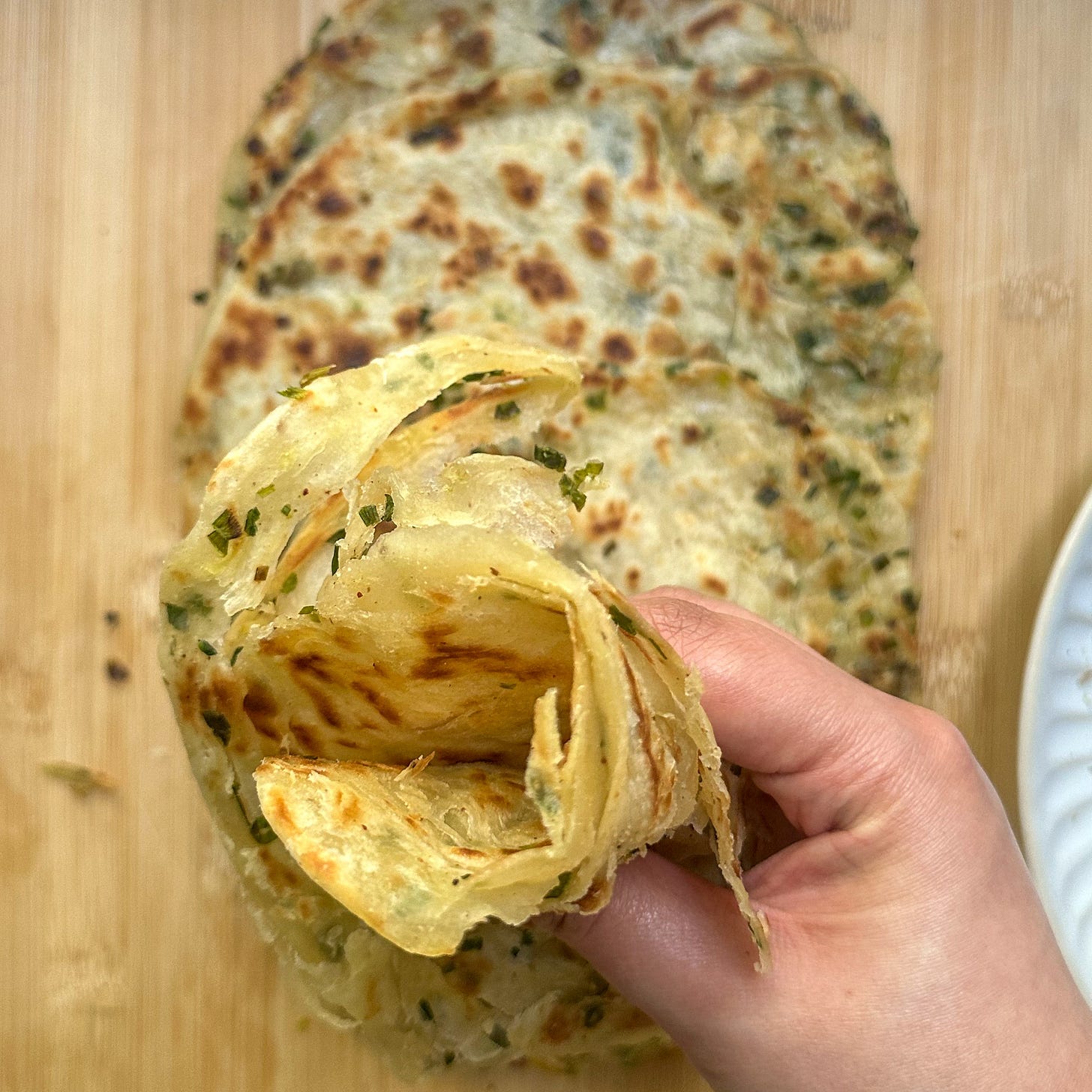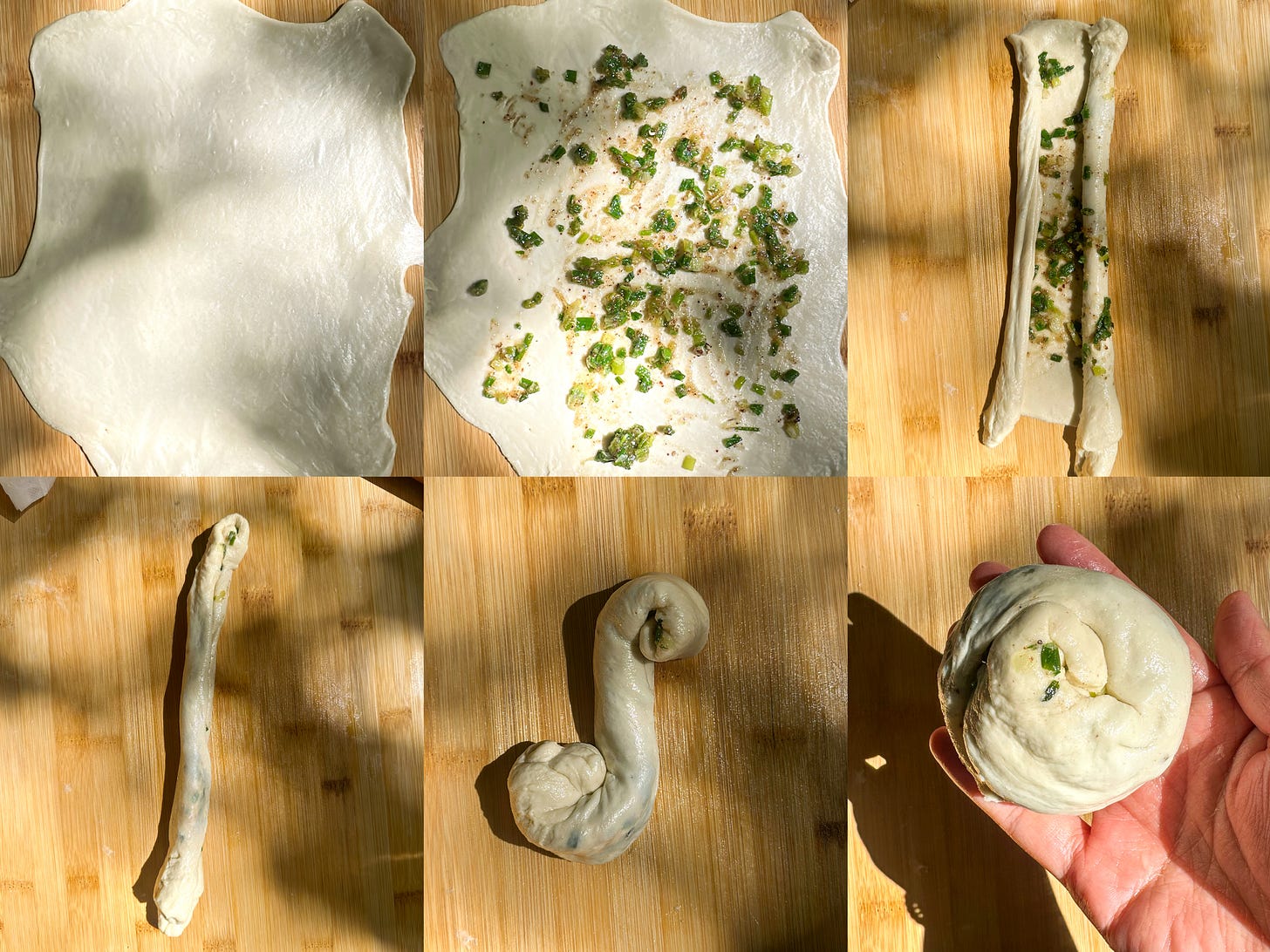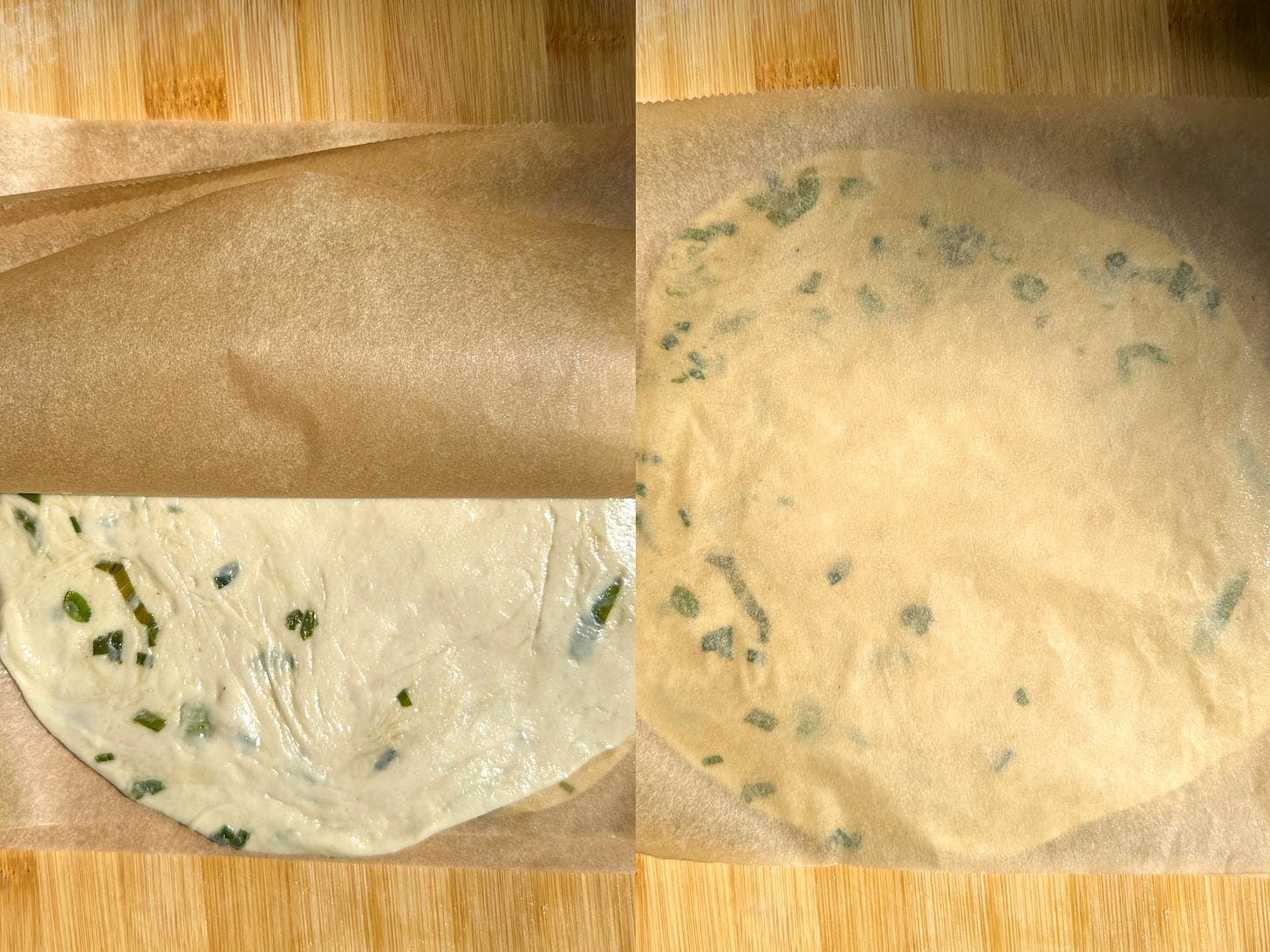Scallion pancakes have been in my repertoire probably since the early lockdowns of 2020, when I was living alone in Berlin—a time that now feels like a lifetime ago. Like many others, I turned to kitchen projects to soften the solitude: I tried baking bread, regrew scallions in water, and whisked dalgona coffee.
I revisited scallion pancakes a couple of times later—once in 2021 with a seasonal twist using wild garlic (ramps), and again in 2022 when I filmed one of my earliest cooking videos (which, looking back, is slightly cringe). One thing I’ve learned as a recipe developer is that we often work so intensely on a dish in a short period that it becomes overwhelming. In Mandarin, there’s a phrase for this: the “sweet burden” (甜蜜的负担) of creation.
After some time away, I found myself drawn back to this recipe. Partly because I genuinely love scallions—I toss a bunch into my cart on every grocery trip, whether I need them or not (though I always find a use). And partly because I have a deep affection for Chinese pancakes in all their forms: crisp, flaky, chewy, or tender. Scallion pancakes manage to be a little bit of each, plus aromatic and satisfying. They’re also one of the most beloved street foods and home-cooked pastries across China, with countless regional styles—from the thick, golden fried Shanghai version to the softer, less oily laobing (烙饼) that’s toasted on a dry or lightly-oiled pan. My version landed in the middle, maybe leaning towards the latter.
So I dug out this recipe and, after some testing, tweaking, and yes, eating a lot of pancakes, I landed on a version that’s more scallion-packed and improved in texture. I experimented with puff pastry as a shortcut, but the result was quite underwhelming (I found it too oily), so we’re sticking with the traditional method.
These pancakes are versatile: great on their own, dipped in sauce, used as wraps, or stashed in the freezer for future cravings. In the following week, I’ll share ways to turn them into fast, flavorful street foods.
Scallion Pancakes | 葱油饼 (Cōng Yóu Bǐng)
Makes 4 pancakes
(I recommend using a kitchen scale here)
Ingredients
For the Dough (approx. 65% hydration)
250g (2 cups) all-purpose flour
80g boiling water
80g room-temperature or cool water
½ tsp salt
For the scallion oil paste (you su)
3–4 scallions (about 60g), roots reserved
2 tbsp all-purpose flour
4 tbsp neutral vegetable oil
¼ tsp Chinese five-spice powder
½ tsp salt
vegetable oil for frying
dipping sauce: chili oil (chili crisp), sweet soy sauce, Chinese black vinegar
Instructions
1. Make the dough: In a bowl, mix flour and salt. Slowly pour in the boiling water while stirring with chopsticks until small clumps form. Add room-temperature water and knead with your hands until the dough comes together with no dry spots. It should feel soft. Cover and let rest for 30 minutes.
2. To make the scallion oil paste: Wash the scallions and reserve the scallion roots. Thinly slice scallions, separating the whites (and light green parts) and greens. In a small pan, heat oil over medium. Add scallion roots and fry until golden, then discard. Add scallion whites and sauté for 2 minutes, then add most of the greens, cook for 1 minute. Stir in flour. Cook until it forms a lightly golden, glossy paste. Remove from the heat, add the remaining scallion greens, five-spice powder, ground Sichuan pepper, and salt. Let cool.
3. Split the dough into 4 equal pieces (~100g each). Brush lightly with oil, cover, and rest for 30 minutes.
4. Oil your surface and rolling pin. Roll out each dough piece into a thin rectangle. Spread with scallion oil paste, leaving some space at the edge. Roll from both long sides toward the center to form a tight log, pressing out air as you go. Coil into snail shapes from both ends, then stack the two sides on top of each other and tuck the ends. Flatten slightly. If the dough is not malleable, let it rest again for 30 minutes (or refrigerate overnight). See the photo breakdown, or watch the video below.
5. Flatten each disk into a round pancake with a rolling pin to about 18-20cm (7-8 inches) in diameter. Don’t worry if some scallions poke through—that’s part of the charm.
6. Heat a thin layer of oil in a nonstick or well-seasoned pan over medium-low. Fry each pancake until golden on both sides. Use two spatulas to press in from the edges toward the center to loosen up the layers. Serve hot with dipping sauce or use as a wrap. (For a Shanghai-style scallion pancake, roll out the dough into smaller discs at step 5, and shallow-fry in more oil until crisp and deeply golden.)
How to make the best Scallion Pancakes
The Half-Hot Water Dough
This dough combines boiling and cool or room-temperature water, known as ban tiangmian (半烫面). The boiling water cooks and gelatinizes some of the flour, making the dough softer and easier to roll—a technique also used in other pastries across the world. In Chinese cooking, half-hot water dough (like in this tofu and chive pocket) or full-hot water dough (全烫面) is mostly used for steamed dumplings and pastries.
My original recipe used 70% hydration, but with this batch of German 405 wheat flour, which is similar to Chinese medium-gluten flour and American all-purpose flour, the dough was almost too sticky to handle (resting helps). So I reduced the water to approximately 65% hydration. But the flour varies, so start with a bit less water and adjust as needed. Aim for a dough that’s soft, slightly sticky, but workable with oiled hands.
A Scallion-infused Oil Paste (You Su)
If there’s one constant across all scallion pancake recipes, it’s the you su (油酥)—a roux-like paste made from flour and vegetable oil, sometimes with lard. This paste is the secret to the pancake’s flaky, layered texture. The traditional method is simple: mix hot oil with flour until it becomes a smooth, beige-colored paste. Some recipes pour hot oil over chopped scallions and flour; others add the scallions directly into the paste.
This time, I set out to coax as much scallion flavor as possible into the oil. Having spent a lot of time developing scallion oil for other recipes, I’ve found that using the entire scallion—from root to tip—makes a difference. First, I start by frying the scallion roots. (You can also toss in leftover shallots or red onion at this point—never let an allium go to waste.) Once those are removed, I sauté the white and light green parts of the scallions until lightly caramelized. Then I add most of the green parts, and I stir in the flour to make a sticky paste. At the very end, I reserve a handful of raw chopped scallions to mix in off-heat. You’d have both the caramelized onion-y flavor and a final pop of fresh, sharp flavor. I picked it up while making Beijing-style zhajiang noodles, and it works beautifully here too.
Bonus: wilted scallions make the rolling and shaping easier, helping the paste spread evenly without tearing the dough.
How to Fold and Roll Pancakes
For this recipe, I use the method, inspired by Hannah Che’s excellent guide, where she tested six shaping techniques. Her favorite—Method #2—is also mine. It’s approachable, effective, and yields beautifully layered results.
And here’s a truth I’ve learned after a few years of making these: your pancakes don’t have to be perfect. Some might break open or look a little misshapen. That’s okay. Just patch them up, shape them again, and keep going. They’ll still taste fantastic.
How to Store Scallion Pancakes
Scallion pancakes are easily freezeable. Once shaped (still raw), layer them between sheets of parchment paper, store in a ziplock bag, and freeze laying flat. When you’re ready to cook, there’s no need to thaw—just fry directly from frozen with some oil.
What else to do with leftover scallions:
Scallion Oil Noodles with Braised Pork Cutlet
Hey! This week, we're talking about a recipe that holds a special place in my heart—it's one of the first recipes I ever developed as a food editor: scallion oil noodles, but with an upgrade.












Beautiful write up. I'm going to make these tomorrow with fresh spring onions my neighbor gave me. Should go well with grilled chicken for memorial day.
Wow, yours look fantastic! Now I have to find someplace that makes them for lunch. 🙏 The spicy sauce look amazing too by the way.